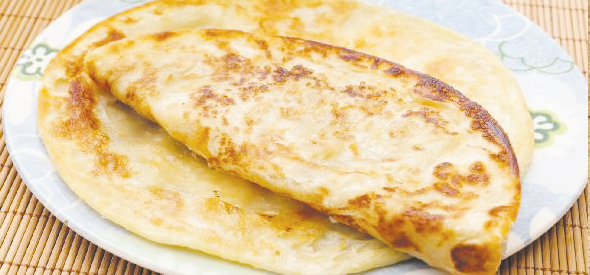Mama’s Punjabi Recipes: Plain Paranthas (Wheat Pancrusted Flatbread)
This was the first recipe I wrote for this column almost four years ago. Since then, I have paid attention to the types of homemade paranthas I have had occasion to eat and try, both in the US and in India and I have been surprised to see that only a very few come close to the type of paranthas that are truly the Old World Punjabi style. I am giving this recipe again, with added details, so that people my make these paranthas in the way they are best enjoyed.
The paranthas that I Iearnt to make as a teenager and young woman before I got married in Lyallpur had to have some very special features to be called worthy of our ancestral home and the Punjabi tradition.
They had to be big – usually 8 to 10 inches round. Then, they had to have the right consistency to be firm, but not hard, to be able to scoop out curry, daal (curried lentils), raita (blended yogurt and garnishing) and subzis (vegetables). The paranthas had to be prepared with some ghee (clarified butter), though now people use oil. And finally, they had to have a crispy, browned top skin.
But, I have noticed with some regret that many of the paranthas that claim to be Punjabi style are lacking in many areas, especially when they are the stuffed type. Most paranthas are too hard, don’t have a crispy outer skin and the plain ones do not fluff up. Many of the stuffed ones are made with potatoes, but these are often quite soft (indicating too much water in the dough) and stay flat, indicating that the potatoes are kneaded into the dough and not stuffed in.
This is quite true either in India or the US, so making a good parantha is somewhat of a dying art. The secret is the atta and the making of the dough by hand, so that you can estimate if the dough is too wet or dry. And rolling the atta into a round pancake requires the right amount of flour and pressure so that there aren’t uneven spots.
The final step is in cooking it over the tava (flat plate) so that the parantha can fluff up, rather than be pushed down against the tava. I have seen many women press down with a spatula but this only makes the bread stick together.
Ingredients:
500gm atta (unbleached wheat flour). Makes 10 paranthas
½ cup tael (vegetable or olive oil)
2 cups thanda pani (cold water)
Directions:
1. Pour the flour in a wide mouthed bowl. Form a small crater and slowly pour the water in while kneading the dough with your hand till it becomes a nice, tender but firm ball, but make sure it is not thin or stingy to when pulled. Add a teaspoon of oil and knead in some more.
2. Dab the surface of the ball with a little water to keep it moist, cover the bowl and set aside for an hour. You can then place it in the fridge for longer duration. If the dough is too hard, the parantha will also be hard.
3. Make dough into small paade (balls) and then roll out into a Punjabi parantha size of 8 to 10 inch circle. (You can make them smaller, but Punjabis eat their paranthas big)
4. Put a small dab of oil on a hot tava (hotplate or skillet) and place the flattened dough on. When it puffs a bit and turn color, turn the pancake over. Put another dab of oil on the tava and then turn it over again till it is fully cooked. Do NOT keep pressing dough on the pancake as this will only make the dough stick together. A well-made parantha will actually puff up!
MAMA’S TIP OF THE WEEK
MAKING THE ATTA DOUGH FOR TASTY PARANTHAS
Making atta for paranthas is an easy task, but there are a few details that will help to make sure that they come out soft but firm. Use cold water for kneading the flour: warm water will make the dough thinner. Too much water will also make the dough thin and difficult to h make into balls and roll out. Grease your hands before pinching off the dough. Pinch off a liberal amount of dough to make a 1.5 to 2 inch ball about . When rolling it out, make the pancake about 1/8th of an inch thick. You can even expand the dough by using both hands, like in making a pizza crust.
Shakuntla Malhotra is a skilled cook of Punjabi dishes made in the old-fashioned style that she learnt as a young woman in her ancestral home in Lyallpur (since renamed Faisalabad), India before it became part of Pakistan after the Partition in 1947. People have often admired her cooking for its simplicity and taste that comes with each mouthful. Even in her mid-eighties, she continues to cook daily and agreed to share some of her delectable Punjabi recipes.


